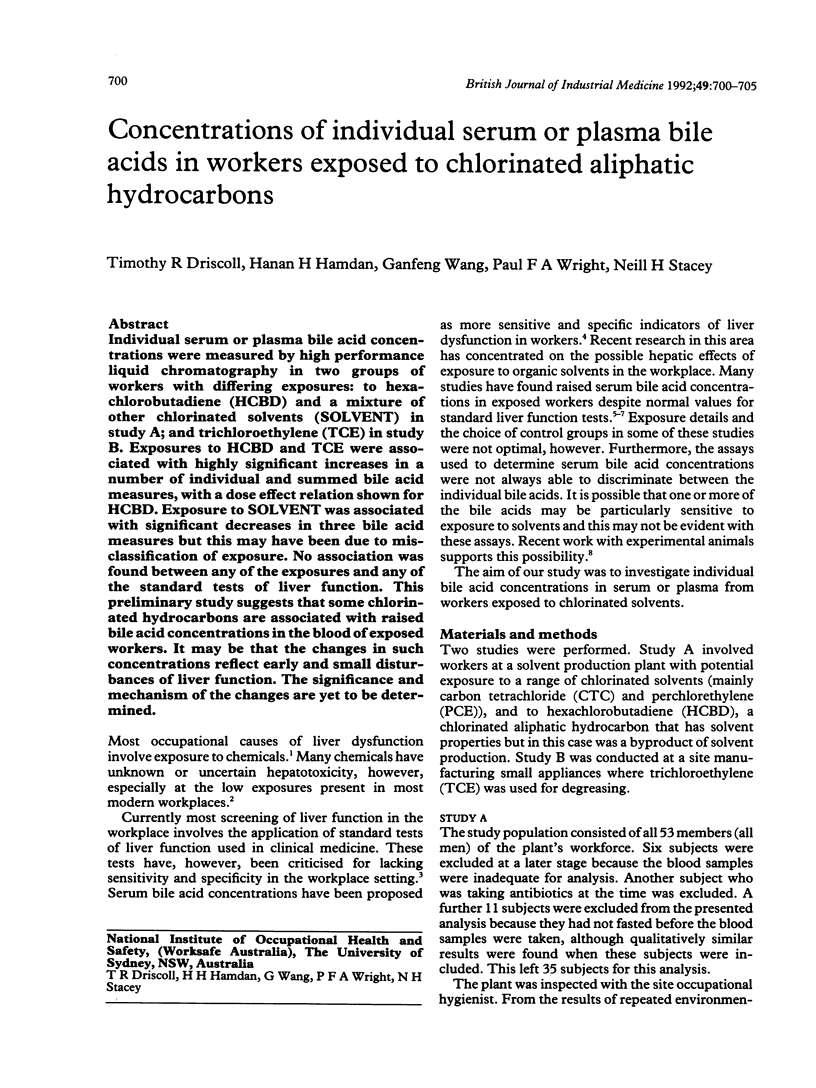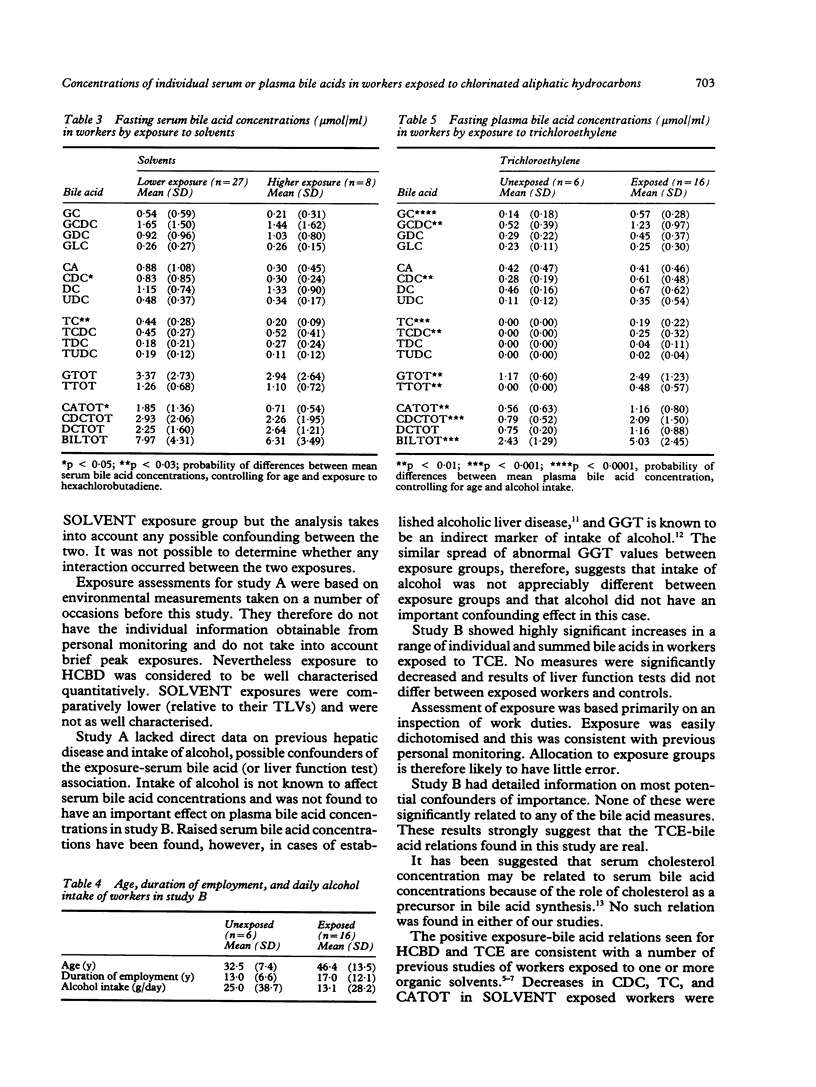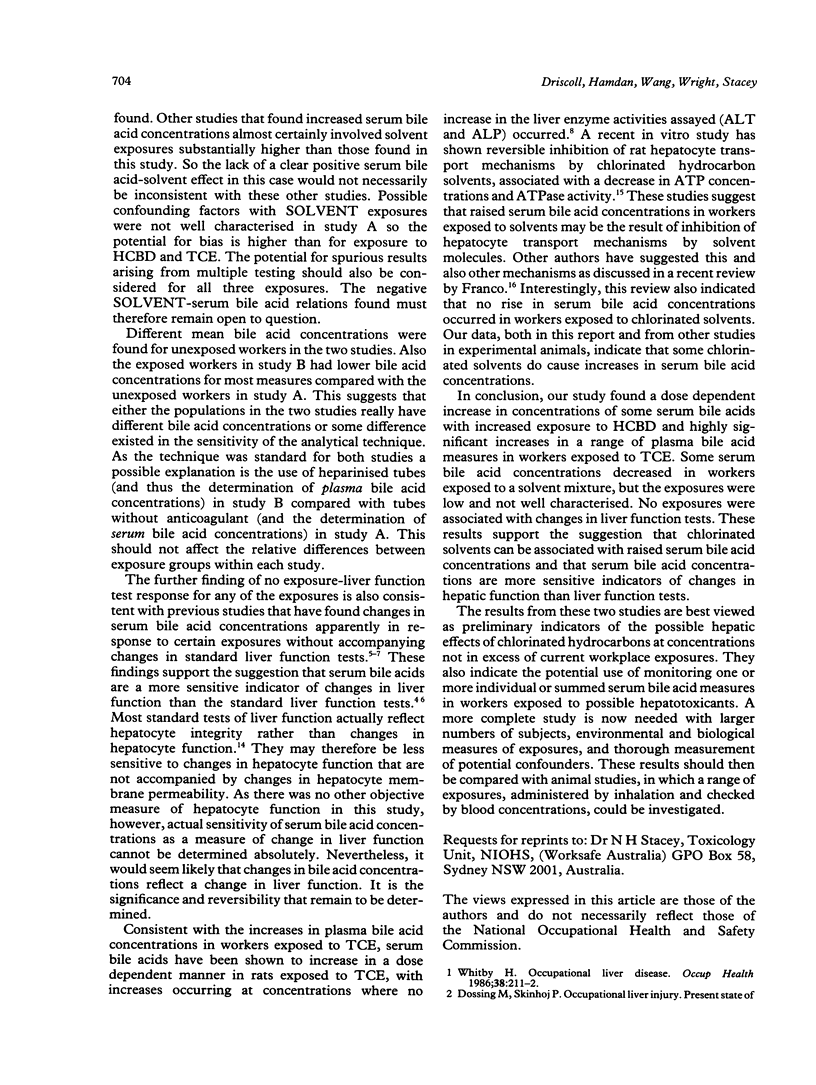Abstract
Individual serum or plasma bile acid concentrations were measured by high performance liquid chromatography in two groups of workers with differing exposures: to hexachlorobutadiene (HCBD) and a mixture of other chlorinated solvents (SOLVENT) in study A; and trichloroethylene (TCE) in study B. Exposures to HCBD and TCE were associated with highly significant increases in a number of individual and summed bile acid measures, with a dose effect relation shown for HCBD. Exposure to SOLVENT was associated with significant decreases in three bile acid measures but this may have been due to misclassification of exposure. No association was found between any of the exposures and any of the standard tests of liver function. This preliminary study suggests that some chlorinated hydrocarbons are associated with raised bile acid concentrations in the blood of exposed workers. It may be that the changes in such concentrations reflect early and small disturbances of liver function. The significance and mechanism of the changes are yet to be determined.
Full text
PDF





Selected References
These references are in PubMed. This may not be the complete list of references from this article.
- Døssing M., Skinhøj P. Occupational liver injury. Present state of knowledge and future perspective. Int Arch Occup Environ Health. 1985;56(1):1–21. doi: 10.1007/BF00380696. [DOI] [PubMed] [Google Scholar]
- Edling C., Tagesson C. Raised serum bile acid concentrations after occupational exposure to styrene: a possible sign of hepatotoxicity? Br J Ind Med. 1984 May;41(2):257–259. doi: 10.1136/oem.41.2.257. [DOI] [PMC free article] [PubMed] [Google Scholar]
- Franco G., Fonte R., Tempini G., Candura F. Serum bile acid concentrations as a liver function test in workers occupationally exposed to organic solvents. Int Arch Occup Environ Health. 1986;58(2):157–164. doi: 10.1007/BF00380767. [DOI] [PubMed] [Google Scholar]
- Franco G. New perspectives in biomonitoring liver function by means of serum bile acids: experimental and hypothetical biochemical basis. Br J Ind Med. 1991 Aug;48(8):557–561. doi: 10.1136/oem.48.8.557. [DOI] [PMC free article] [PubMed] [Google Scholar]
- Franco G., Santagostino G., Lorena M., Imbriani M. Conjugated serum bile acid concentrations in workers exposed to low doses of toluene and xylene. Br J Ind Med. 1989 Feb;46(2):141–142. doi: 10.1136/oem.46.2.141. [DOI] [PMC free article] [PubMed] [Google Scholar]
- Kukongviriyapan V., Kukongviriyapan U., Stacey N. H. Interference with hepatocellular substrate uptake by 1,1,1-trichloroethane and tetrachloroethylene. Toxicol Appl Pharmacol. 1990 Jan;102(1):80–90. doi: 10.1016/0041-008x(90)90085-9. [DOI] [PubMed] [Google Scholar]
- Milstein H. J., Bloomer J. R., Klatskin G. Serum bile acids in alcoholic liver disease. Comparison with histological features of the disease. Am J Dig Dis. 1976 Apr;21(4):281–285. doi: 10.1007/BF01071839. [DOI] [PubMed] [Google Scholar]
- Rosalki S. B. Gamma-glutamyl transpeptidase. Adv Clin Chem. 1975;17:53–107. doi: 10.1016/s0065-2423(08)60248-6. [DOI] [PubMed] [Google Scholar]
- Tamburro C. H., Greenberg R. Effectiveness of federally required medical laboratory screening in the detection of chemical liver injury. Environ Health Perspect. 1981 Oct;41:117–122. doi: 10.1289/ehp.8141117. [DOI] [PMC free article] [PubMed] [Google Scholar]
- Tamburro C. H., Liss G. M. Tests for hepatotoxicity: usefulness in screening workers. J Occup Med. 1986 Oct;28(10):1034–1044. doi: 10.1097/00043764-198610000-00026. [DOI] [PubMed] [Google Scholar]
- Wang G. F., Stacey N. H., Earl J. Determination of individual bile acids in serum by high performance liquid chromatography. Biomed Chromatogr. 1990 Jul;4(4):136–140. doi: 10.1002/bmc.1130040403. [DOI] [PubMed] [Google Scholar]
- Wang G. F., Stacey N. H. Elevation of individual serum bile acids on exposure to trichloroethylene or alpha-naphthylisothiocyanate. Toxicol Appl Pharmacol. 1990 Sep 1;105(2):209–215. doi: 10.1016/0041-008x(90)90182-t. [DOI] [PubMed] [Google Scholar]


